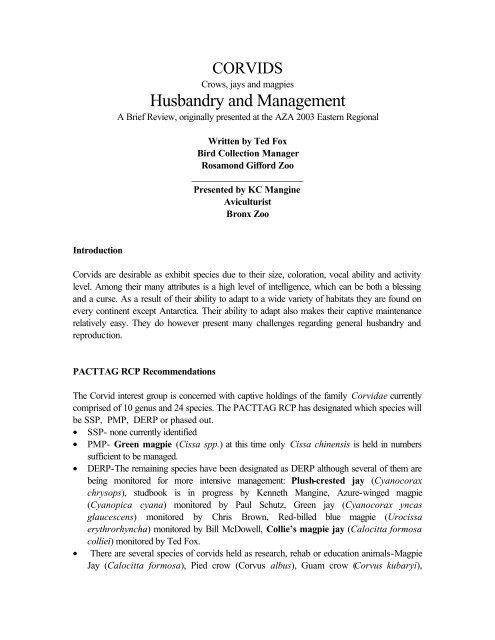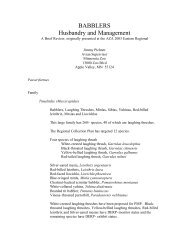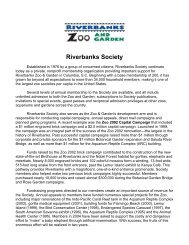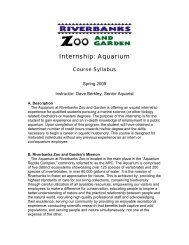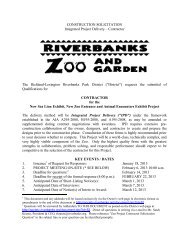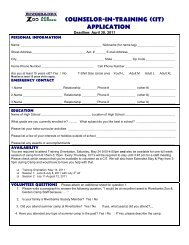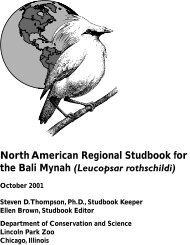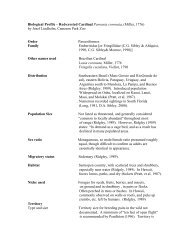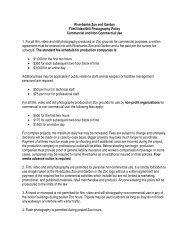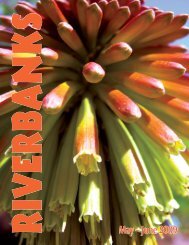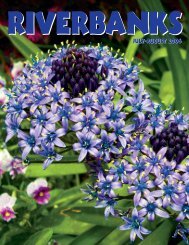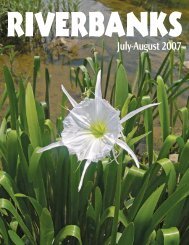Corvids - Riverbanks Zoo and Garden
Corvids - Riverbanks Zoo and Garden
Corvids - Riverbanks Zoo and Garden
You also want an ePaper? Increase the reach of your titles
YUMPU automatically turns print PDFs into web optimized ePapers that Google loves.
Introduction<br />
CORVIDS<br />
Crows, jays <strong>and</strong> magpies<br />
Husb<strong>and</strong>ry <strong>and</strong> Management<br />
A Brief Review, originally presented at the AZA 2003 Eastern Regional<br />
Written by Ted Fox<br />
Bird Collection Manager<br />
Rosamond Gifford <strong>Zoo</strong><br />
_______________________<br />
Presented by KC Mangine<br />
Aviculturist<br />
Bronx <strong>Zoo</strong><br />
<strong>Corvids</strong> are desirable as exhibit species due to their size, coloration, vocal ability <strong>and</strong> activity<br />
level. Among their many attributes is a high level of intelligence, which can be both a blessing<br />
<strong>and</strong> a curse. As a result of their ability to adapt to a wide variety of habitats they are found on<br />
every continent except Antarctica. Their ability to adapt also makes their captive maintenance<br />
relatively easy. They do however present many challenges regarding general husb<strong>and</strong>ry <strong>and</strong><br />
reproduction.<br />
PACTTAG RCP Recommendations<br />
The Corvid interest group is concerned with captive holdings of the family Corvidae currently<br />
comprised of 10 genus <strong>and</strong> 24 species. The PACTTAG RCP has designated which species will<br />
be SSP, PMP, DERP or phased out.<br />
• SSP- none currently identified<br />
• PMP- Green magpie (Cissa spp.) at this time only Cissa chinensis is held in numbers<br />
sufficient to be managed.<br />
• DERP-The remaining species have been designated as DERP although several of them are<br />
being monitored for more intensive management: Plush-crested jay (Cyanocorax<br />
chrysops), studbook is in progress by Kenneth Mangine, Azure-winged magpie<br />
(Cyanopica cyana) monitored by Paul Schutz, Green jay (Cyanocorax yncas<br />
glaucescens) monitored by Chris Brown, Red-billed blue magpie (Urocissa<br />
erythrorhyncha) monitored by Bill McDowell, Collie’s magpie jay (Calocitta formosa<br />
colliei) monitored by Ted Fox.<br />
• There are several species of corvids held as research, rehab or education animals-Magpie<br />
Jay (Calocitta formosa), Pied crow (Corvus albus), Guam crow (Corvus kubaryi),
Common crow (Corvus brachyrhynchos), Raven (Corvus corax), Chihuahuan raven<br />
(Corvus cryptoleucus), Fish crow (Corvus ossifragus), Scrub jay (Aphelocoma<br />
coerulescens) Blue jay (Cyanocitta cristata) Black-billed magpie (Pica pica <strong>and</strong> Pica<br />
pica hudsonica).<br />
• Two species are under consideration for possible DERP designation- Nutcracker<br />
(Nucifraga caryocatactes caryocatactes), <strong>and</strong> Chough (Pyrrhocorax pyrrhocorax).<br />
• The remaining captive held corvids are recommended to be phased out: Purplish-backed<br />
jay (Cissolopha beecheii), San Blas jay (Cissolopha sanblasiana), white-necked raven<br />
(Corvus albicollis), carrion crow (Corvus corone), racket-tailed treepie (Crypsirina<br />
temia), white-tailed jay (Cyanocorax mysticalis), rufous treepie (Dendrocitta<br />
vagabunda), Eurasian jay (Garrulus gl<strong>and</strong>arius), crested jay (Platylophus<br />
galericulatus).<br />
Housing<br />
Housing <strong>and</strong> managing corvids is both challenging <strong>and</strong> rewarding. Even housing corvids in single<br />
species exhibits has its difficulty. <strong>Corvids</strong> are renowned for their intelligence <strong>and</strong> territoriality,<br />
making the job of keeping them occupied a formidable task. It is imperative that their exhibit has<br />
an abundance of space <strong>and</strong> complexity. Obviously the larger the enclosure the easier it is to<br />
incorporate complexity. It is possible however, to house them in smaller spaces if enrichment<br />
<strong>and</strong> training are made a priority. Perching should be available in a variety of sizes <strong>and</strong> textures,<br />
utilizing as many strata as possible. Most corvids will become comfortable going to the ground,<br />
especially if rocks <strong>and</strong> logs are provided. Mid range strata should be used for enrichment <strong>and</strong><br />
feeding, upper level for roosting <strong>and</strong> nesting. Shelter should be provided based on climate <strong>and</strong><br />
species, ranging from a simple windbreak to a heated indoor enclosure. Natural substrate is<br />
preferred as it provides enrichment in additional to being esthetically pleasing. Care should be<br />
taken to monitor substrate for cached food to avoid disease vectors. Coarse s<strong>and</strong> makes an<br />
ideal substrate as it allows birds to dig, provides drainage <strong>and</strong> facilitates cleaning.<br />
Social Management<br />
Most species of corvids are gregarious during some part of the annual cycle, although it is not<br />
necessary to replicate this in order for these species to breed. Many species are known to be<br />
cooperative breeders in the wild. A few cases have been documented mimicking this breeding<br />
strategy in captivity successfully, however, more often than not attempting this results in failure,<br />
possibly due to our inability to precisely duplicate all the factors that exist in wild situations.<br />
Typically housing a male <strong>and</strong> female together results in a functional pair bond. When there is a<br />
lack of stimulation in the exhibit it is possible for the bond to degrade resulting in displaced<br />
aggression <strong>and</strong> loss of production.<br />
If h<strong>and</strong>-rearing corvids is a necessity, early exposure to conspecifics will aid in maintaining<br />
natural behavior. Long periods of imprintation make it possible to integrate other birds for<br />
socialization. H<strong>and</strong> reared birds frequently present difficulty in forming pair bonds due to their
connection with their caretakers. This can be overcome with sufficient effort at disengaging the<br />
bird’s interest towards humans in favor of their natural companion as early as possible.<br />
When very large enclosures are available, groups of single species gregarious birds can be<br />
successfully displayed.<br />
To facilitate successful management, regardless of the size of the enclosure, a trap/howdy unit is<br />
beneficial for many reasons. This cage can be used for separating birds that are aggressive to<br />
each other <strong>and</strong> for introductions. In large enclosures trap units will expedite capture when<br />
necessary.<br />
Breeding<br />
Corvid breeding has been sporadic at best. Breeding can occur either off or on exhibit if the<br />
right conditions are provided. At the onset of the breeding season, it is imperative that<br />
enrichment frequency <strong>and</strong> variety is increased. Offering live food at this point can help insure a<br />
favorable season. Generally, a well-bonded pair will need to be provided with a space that<br />
incorporates height <strong>and</strong> distance from care-taking staff <strong>and</strong> visitors. Female temperament should<br />
be a consideration in nest placement. Nervous females may be induced to breed with a wellplaced<br />
nesting area. Some females may prefer areas that enable them to scan their surroundings<br />
while others may prefer to be concealed. Providing choices when preference has not been<br />
determined will increase the chances of breeding success. Species- specific nesting material<br />
should be provided frequently <strong>and</strong> in large amounts. Again a variety of materials should be<br />
provided to allow birds to have choice. Platforms <strong>and</strong>/or nest baskets can be given to provide a<br />
basic structure for building. It is possible for birds to construct a completely natural nest without<br />
a supporting structure if the exhibit is very large with natural plantings <strong>and</strong> vegetation. Females<br />
do all the incubation; males assist with nest building <strong>and</strong> feeding the female throughout incubation<br />
<strong>and</strong> early chick rearing. As the chicks mature the male will help feed them. A commonly<br />
encountered problem with captive rearing is predation of eggs <strong>and</strong> newly hatched young,<br />
particularly by the male. If this occurs it is recommended that the male be removed from the<br />
nesting area, ideally to an immediately adjacent area where visual <strong>and</strong> vocal contact can be<br />
maintained but physical danger can be averted. The female is capable of incubating <strong>and</strong> feeding<br />
chicks without assistance if necessary. Reintroducing the male when chicks have reached 10-20<br />
days of age may increase the chance of chicks surviving to maturity. This reintroduction must be<br />
carefully monitored. Parents must have access to appropriate food items to feed chicks.<br />
Crickets are a preferred food item for many species. Mealworms, wax moth larvae, <strong>and</strong> pinky<br />
mice are other items that should be offered.<br />
Average clutch size is 2-4 eggs, color is light bluish-green with darker speckles for most<br />
species. Incubation length is from 16-22 days, depending on species.<br />
Diet
<strong>Corvids</strong> are omnivores, making them fairly easy to feed adequately outside the breeding season.<br />
During breeding, as previously noted, a more complex diet is necessary. The basic diet should<br />
consist of a protein source, fruit, vegetable <strong>and</strong> fiber. There are several extruded pellets on the<br />
market that can serve as the foundation of a balanced, readily accepted diet. Some examples<br />
are Marion <strong>Zoo</strong>logical Jungle <strong>and</strong> Paradise pellets, Purina Nutrablend pigeon pellets, <strong>and</strong><br />
Kaytee Exact pellets. These pellets can be supplemented with the addition of fresh fruits <strong>and</strong><br />
vegetables, mice, quail, day old chicks, fish, nuts <strong>and</strong> live food.<br />
Exhibition<br />
The safest manner of display is in single species enclosures. It is possible to house corvids in<br />
mixed species habitats if careful consideration is given to species selection <strong>and</strong> enclosure<br />
parameters. There are current exhibits in which corvids are successfully exhibited with<br />
mammals, reptiles <strong>and</strong> various other bird species. Some factors necessary for this success are<br />
enclosure size <strong>and</strong> complexity; species selection based on personality <strong>and</strong> complementary<br />
behavior patterns. Breeding in these enclosures will add a degree of difficulty.<br />
Health<br />
<strong>Corvids</strong> tend to be fairly hardy although recently West Nile Virus has become a major concern<br />
in birds that are housed outdoors. They are as susceptible as other species to the usual avian<br />
diseases (such as aspergillosis, atoxoplasmosis, avian tuberculosis <strong>and</strong> malaria). In the case of<br />
h<strong>and</strong> fed birds, foot problems directly related to improper nest substrate from hatch to fledge,<br />
are also prevalent. Access to open fresh water for bathing is important for maintenance of<br />
plumage. Hyperkarotosis in corvids as well as other passerine species can be a problem that is<br />
most commonly be linked to inadequate diet.<br />
Acquisition<br />
Limited numbers of birds are still being brought into captivity from the wild. This will continue to<br />
be necessary to maintain genetic diversity. In the past we have relied heavily on wholesalers <strong>and</strong><br />
importers to provide us with desired specimens. It is imperative that captive breeding is<br />
accomplished to fill spaces. Restrictions on importation will only become more stringent in the<br />
future. <strong>Zoo</strong>s will need to be more active in pursuing importation. Riverbank’s acquisition of a<br />
large number of hoopoes for multiple facilities is an example of one institution acting for the good<br />
of many. For some species in need in situ programs will be more practical than importation (i.e.<br />
Guam crow). Cooperation with private individuals is one way to insure ample genetic material<br />
for population management. Acquisition policies can be developed to facilitate this cooperation.<br />
American Federation of Aviculture’s Model Aviculture Program certification (or similar<br />
process) could be used as a basis upon which a private individual or facility could be qualified to<br />
participate with a cooperative program.
Education<br />
<strong>Corvids</strong> are very trainable. They work well in public programs allowing the visitor a close up<br />
look at a bird. <strong>Corvids</strong> are also extremely adaptable to human <strong>and</strong> environmental pressure.<br />
Education programs can be devised to explain the benefits of adaptability using corvids as a<br />
model. The cosmopolitan nature of corvids makes them familiar to people in all parts of the<br />
world, making it possible to draw a correlation between an exotic Jay species <strong>and</strong> a native Blue<br />
Jay.<br />
Enrichment<br />
Developing a usable training <strong>and</strong> enrichment program for corvids is beneficial to the individual<br />
birds <strong>and</strong> can ultimately be the difference between a successful breeding program <strong>and</strong> one that<br />
results in failure. Training does not have to mean flying through hoops but having birds that will<br />
shift to an adjacent holding or a trap-unit is important if individuals need to be separated while<br />
minimizing stress. Training birds to station for close visual inspections can be extremely<br />
beneficial when trying to ascertain the health of individual specimens.<br />
Enrichment is extremely important to the well being <strong>and</strong> successful husb<strong>and</strong>ry of corvids.<br />
Possibilities for enrichment are almost endless <strong>and</strong> a little imagination will go a long way. As<br />
corvids are intelligent <strong>and</strong> naturally curious, providing them with a problem to solve can keep<br />
them mentally <strong>and</strong> physically occupied for long periods of time. For example, food items can be<br />
hidden in various areas of their enclosure or concealed in layers of cardboard boxes or paper.<br />
Items that make noise like baby rattles or bells are often favorites. They also enjoy things that<br />
can be torn apart: cloth, paper <strong>and</strong> boxes offer a great deal of amusement (to both bird <strong>and</strong><br />
keeper). Natural food items are also very enriching as the birds are allowed to shred a favored<br />
food prior to consuming it. Quail, chickens, fish, rabbits, rats <strong>and</strong> similar items keep a corvid<br />
active, sometimes for hours. There are several commercially available enrichment devices that<br />
are actually marketed for psittacines but are ideal for corvids. In a naturalistic exhibit where<br />
artificial devices are undesirable, it is relatively simple to create enrichment devices using natural<br />
items such as logs, piles of leaves, gravel, rocks <strong>and</strong> pools of water.


